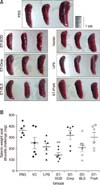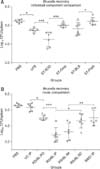Abstract
Figures and Tables
Fig. 1
Humoral immune responses induced by individual Salmonella Typhimurium (ST)-recombinant Brucella strains. The level of specific systemic immunoglobulin G (sIgG) production against the Brucella antigen was investigated by using indirect enzyme-linked immunosorbent assay. (A) The titers of sIgG specific to Brucella SOD of mice immunized with ST-SOD. (B) The titers of sIgG against Brucella Omp19 of mice immunized with ST-Omp. (C) The titers of sIgG against Brucella BLS of mice immunized with ST-BLS. (D) The titers of sIgG against Brucella PrpA of mice immunized with ST-PrpA. Antibody levels are expressed as mean OD492 ± SE. OD492, optical density at 492 nm; PBS, phosphate-buffered saline; SOD, Cu-Zn superoxide dismutase; VC, vector control; PI, post-immunization; Omp, outer membrane protein; BLS, Brucella antigens lumazine synthase; PrpA, proline racemase subunit A; ST-SOD, rough S. Typhimurium delivering Brucella SOD antigen; ST-Omp, rough S. Typhimurium delivering Brucella Omp19 antigen; ST-BLS, rough S. Typhimurium delivering Brucella BLS antigen; ST-PrpA, rough S. Typhimurium delivering Brucella PrpA antigen. Significant difference from the PBS control group, *p ≤ 0.05, **p ≤ 0.005. Significant difference from the VC group, #p ≤ 0.05, ##p ≤ 0.005.

Fig. 2
The level of specific immunoglobulin G (IgG) against each Brucella antigen was investigated in mice immunized with a cocktail of Salmonella typhimurium (ST)-Brucella strains via the oral or IP routes. The titers of the systemic IgG response against Brucella SOD (A), Brucella Omp19 (B), Brucella BLS (C), and Brucella PrpA (D) were observed in mice immunized with ST-PrpA through the different routes. Antibody levels are expressed as mean OD492 ± SE. SOD, Cu-Zn superoxide dismutase; Omp19, outer membrane protein-19; BLS, Brucella antigens lumazine synthase; PrpA, proline racemase subunit A; PBS, phosphate-buffered saline; RSrBL, rough Salmonella-delivered recombinant Brucella antigens and lipopolysaccharide; IP, intraperitoneal; VC, vector control; WPI, weeks post-immunization. Significant difference from the PBS control group, *p ≤ 0.05, **p ≤ 0.005. Significant difference from the VC group, #p ≤ 0.05, ##p ≤ 0.005.

Fig. 3
Relative cytokine quantification. Fold change in expression of splenocyte cytokines upon in vitro Brucella sonicated lysate antigen stimulation was determined by quantitative polymerase chain reaction. Values represent relative expression of the cytokine normalized to the β-actin endogenous control. (A) Relative expression of the interleukin (IL)-17 cytokine. (B) Relative expression of the IL-23 cytokine. Relative cytokine levels are expressed as mean fold change ± SE. The asterisks indicate significant differences between cytokine expression of the immunized group and the non-immunized PBS group (*p ≤ 0.05). PBS, phosphate-buffered saline; IM, intramuscular; SC, subcutaneous; IP, intraperitoneal.

Fig. 4
Comparative splenic size and morphology. Representative spleen samples from each mouse group were aseptically isolated. (A) Appearance and relative size of spleens isolated from the mouse groups. (B) Relative differences in splenic weights of the mouse groups. Compared to spleens in the vaccinated groups, spleens of non-immunized mice were enlarged; however, there was no strong correlation between splenic weight and vaccine protection as non-enlarged spleens also harbor a considerable load of challenge bacteria. PBS, phosphate-buffered saline; ST-SOD, rough Salmonella Typhimurium delivering Brucella SOD antigen; ST-Omp, rough S. Typhimurium delivering Brucella Omp19 antigen; ST-BLS, rough S. Typhimurium delivering Brucella BLS antigen; LPS, lipopolysaccharide; ST-PrpA, rough S. Typhimurium delivering Brucella PrpA antigen; VC, vector control. **p ≤ 0.005.

Fig. 5
Splenic bacterial recovery. The colony-forming unit (CFU) level of the challenge strain Brucella abortus 544 was determined. The reduction in the splenic CFU count is correlated with protection. (A) Bacterial recovery after immunization with individual Salmonella Typhimurium (ST)-Brucella strains. Mice immunized with the ST-SOD strain had the lowest bacterial count, which indicates ST-SOD provided the highest level of protection. All individual immunization components, except ST-PrpA, showed a significant level (p ≤ 0.05) of protection. (B) Immunization route comparison. The lowest bacterial count was observed in mice immunized via the IP route, followed by the IM, SC, and oral routes. The data are represented as log10 CFU/spleen. PBS, phosphate-buffered saline; LPS, lipopolysaccharide; ST-SOD, rough S. Typhimurium delivering Brucella SOD antigen; ST-Omp, rough S. Typhimurium delivering Brucella Omp19 antigen; ST-BLS, rough S. Typhimurium delivering Brucella BLS antigen; ST-PrpA: rough S. Typhimurium delivering Brucella PrpA antigen; VC, vector control; IP, intraperitoneal; RSrBL, rough Salmonella-delivered recombinant Brucella antigens and lipopolysaccharide; IM, intramuscular; SC, subcutaneous. Significant difference between indicated groups, *p ≤ 0.05, **p ≤ 0.005, ***p ≤ 0.0005.

Table 2
Immunization and challenge scheme

IP, intraperitoneal; PBS, phosphate-buffered saline; LPS, lipopolysaccharide; IM, intramuscular; SC, subcutaneous; CFU, colony-forming unit; SOD, Cu-Zn superoxide dismutase; Omp, outer membrane protein; BLS, Brucella antigens lumazine synthase; PrpA, proline racemase subunit A; ST-SOD, rough Salmonella Typhimurium delivering Brucella SOD antigen; ST-Omp, rough S. Typhimurium delivering Brucella Omp19 antigen; ST-BLS, rough S. Typhimurium delivering Brucella BLS antigen; ST-PrpA, rough S. Typhimurium delivering Brucella PrpA antigen. *n = 8 per group. †Rough Salmonella delivering recombinant Brucella antigens and LPS formulation, four rough strains JOL1800 Salmonella live vectors−JOL1878, JOL1879, JOL1880, and JOL1881, each constitutively expressing Brucella immunogenic protein, i.e., SOD, BLS, PrpA, and Omp19; combined with purified LPS isolated from strain 544.




 PDF
PDF ePub
ePub Citation
Citation Print
Print



 XML Download
XML Download